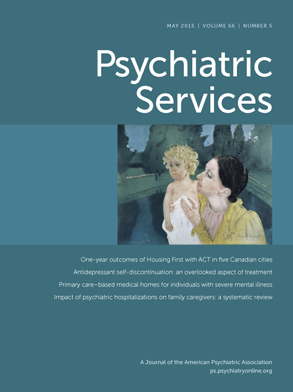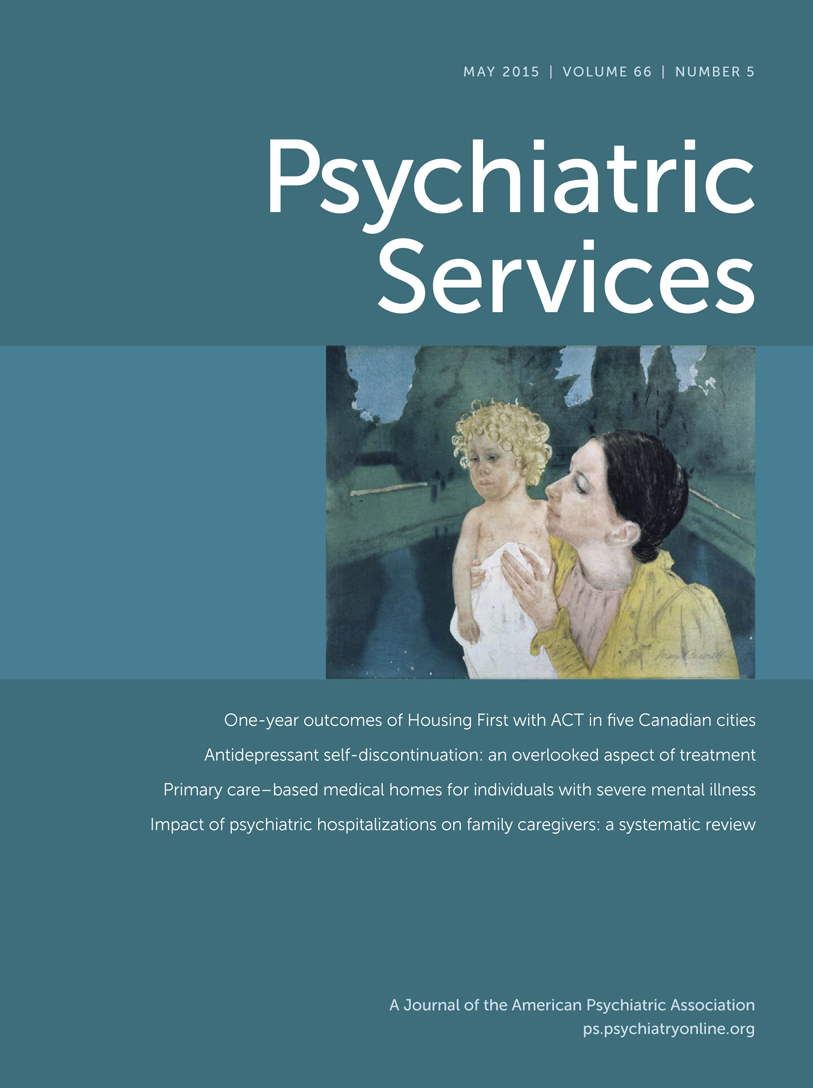Co-occurring mental and substance use disorders are common among individuals who receive psychiatric services, and the presence of co-occurring disorders increases symptom severity, complicates treatment, and leads to poor client outcomes (
1). Thus, to improve treatment for a substantial portion of their clientele, mental health providers should deliver services that address the specific needs of individuals with co-occurring disorders (
2). Yet the provision of co-occurring disorder services remains the exception in most mental health treatment settings (
3–
6). Researchers have identified several interrelated reasons for this: mental and substance use disorder services traditionally have been provided by different systems of care, each with its own administrative, financial, and human resource restrictions (
1,
7); program structure, program milieus, assessment procedures, treatment modalities, and continuity of care protocols in many mental health clinics are not well suited to meet the needs of clients with co-occurring disorders (
3–
6); and when mental health providers try to collaborate with specialty substance abuse treatment providers, challenges associated with treatment access and care coordination are significant (
1,
7).
Policy makers and administrators hoped that the transformation of the nation’s mental health system, as recommended by 2003’s report of the President’s New Freedom Commission, would address many of these challenges. The New Freedom Commission envisioned that a transformed mental health system would provide integrated treatment for co-occurring disorders and overcome the funding, regulatory, and programmatic barriers that have historically hindered the delivery of integrated care (
8). However, little research has studied whether system transformation has overcome these problems. Using qualitative methods, we analyzed the extent to which system transformation has removed long-standing barriers to the delivery of co-occurring disorder services for mental health clients.
Results
Two major themes emerged from focus group discussions: barriers within the mental health system persist and complicate the delivery of services for clients with co-occurring disorders, and barriers continue to complicate the coordination of mental health services with specialty substance abuse treatment. [A box on this page summarizes these themes and barriers.]
Focus group participants identified three specific issues within the mental health system that hinder the delivery of effective co-occurring disorder services: organizational failure to sustain integrated care, limited support for co-occurring disorder treatment training, and diagnostic and billing restrictions.
Participants reported that organizational failure to sustain integrated service delivery hinders their ability to serve clients with co-occurring disorders. Across clinic sites, participants mentioned that their treatment organizations no longer provide as much time or resources as were available in the past to address clients’ substance use behaviors. At one clinic, participants reported that management discontinued opportunities to consult with outside experts in co-occurring disorder treatment who worked at a local substance abuse treatment agency; at another, participants mentioned that their clinic had tested clients for drugs but had discontinued doing so; and at several clinics, participants mentioned that they had devised procedures for identifying and treating clients with co-occurring disorders but that clinic management never implemented them. Although these treatment organizations had either instituted protocols to improve care for clients with co-occurring disorders or had planned to provide more integrated care, their leaders had not continued to support these initiatives.
Focus group participants also reported that their clinic leadership did not provide enough opportunities for training in regard to treatment of co-occurring disorders. Despite the prevalence of substance use disorders among their clientele, participants reported that many clinicians are uncomfortable discussing alcohol or drug issues with clients. Additional training, they suggested, could address this issue. Yet participants reported that training opportunities are limited and that practical pressures to manage large caseloads and accumulate billable hours often trump training needs. “There’s a lot of emphasis on our productivity,” one social worker explained. “When we’ve asked for things like trainings, we’ve gotten [the response from management] ‘You guys are underperforming.’” Consequently, participants reported that the majority of what they knew about co-occurring disorders came from on-the-job learning through improvised consultation and trial and error rather than formal training.
Providers reported that restrictions concerning diagnostic criteria and billing also complicate the delivery of integrated care for clients with co-occurring disorders. To be billable, all services need to be specifically targeted to mental disorders, as defined by psychiatric diagnostic criteria. Consequently, all services, as documented in charts and paperwork, need to focus on clients’ mental health; substance use behaviors can be addressed but only as a means to improve psychiatric outcomes and functioning. At some sites, clinicians reported working around these bureaucratic restrictions by formally reporting that their services focused on mental health, even if treatment mainly targeted clients’ substance use. “It’s just a separation between what’s on the document and what you’re doing during the session,” one nurse practitioner explained. However, other providers reported that they had difficulty documenting how interventions focused on substance use were related to psychiatric treatment goals and services. “Billing always needs to tie into . . . what’s on the assessment, which is primarily going to be depression, anxiety,” explained one provider. “Unfortunately, just having a co-occurring disorder is not going to work [for billing purposes],” even if services to address substance use are interrelated with clients’ mental health goals.
Focus group participants identified three specific issues related to care coordination that hinder the delivery of effective co-occurring disorder services: perceived shortcomings of the substance abuse treatment system, challenges communicating with substance abuse treatment providers, and difficulty reconciling different treatment approaches.
Providers reported that shortcomings of the local substance abuse treatment system make coordinated care difficult to provide. Many providers noted that local substance use disorder services are fragmented and incomplete. Although a division of the Los Angeles County Department of Public Health administers contracts to hundreds of community-based substance abuse treatment agencies, some providers were unaware that the county provides substance abuse treatment. Other providers reported that identifying available services and determining which programs are appropriate for their clients is a cumbersome and time-consuming process. Furthermore, slots in substance use disorder programs are exceedingly scarce, with waitlists of weeks or months. Participants reported that program admission procedures often exacerbate these problems; most programs require clients to call regularly before they can be admitted. Long wait times and bureaucratic hurdles, they explained, were counterproductive because of the difficulties inherent in engaging clients in substance abuse treatment. As one provider explained, “When somebody’s ready to go to detox, you’ve got to get them into detox right away.” Furthermore, providers reported that the few substance abuse treatment services available are too brief to have meaningful clinical effects, lasting only a few weeks, with little aftercare.
Participants reported that communicating with substance abuse treatment providers was also challenging. Many residential treatment programs, they explained, have regulations precluding clients from speaking with providers outside their program, thus making it difficult for providers to monitor the progress of their clients in substance abuse treatment. Participants also reported that heavy caseloads and time constraints make maintaining regular contact with substance abuse treatment service providers impractical. Initiating and maintaining contact with providers at other agencies, one participant explained, generally devolves into frustrating games of “phone tag.” Providers reported that confidentiality concerns and substance abuse treatment agency policies concerning disclosure of client information also stymie efforts to coordinate care. Furthermore, they reported that billing for interagency contacts is an administratively onerous process, sometimes requiring providers to spend more time filling out billing paperwork for a telephone consultation than they actually spent on the call. Thus “working really closely with drug and alcohol treatment centers,” summarized one psychologist, “is not something that we regularly do.”
Providers also reported that providers of substance abuse treatment sometimes use treatment approaches that differ from those used by mental health providers and that these approaches are difficult to reconcile with standard psychiatric practice. “It gets messy,” one social worker explained, “[when] there are too many cooks in the kitchen.” In particular, participants mentioned experiences with clients who attended 12-step–oriented programs that discourage the use of psychotropic medications, even those prescribed by a psychiatrist. “I ask why they’re off meds,” one clinician reported, “[and they say] ‘because my AA sponsor told me not to take medications.’ So they end up in the hospital and come here in a crisis.” Thus, even when substance abuse treatment services are accessible, ensuring that they do not interfere with mental health treatment is often a difficult task.
Discussion
Despite system transformation under the MHSA, focus group participants reported that many obstacles continue to hinder the delivery of integrated care for clients with co-occurring disorders. Within the mental health system, organizational failure to sustain integrated care, limited support for providing training in co-occurring disorders, and restrictive diagnostic and billing criteria inhibit the consistent delivery of services that are tailored to the needs of clients with co-occurring disorders. These challenges are exacerbated by issues related to collaborating with specialty substance abuse treatment organizations, including perceived shortcomings of the substance abuse treatment system, communication challenges, and difficulty reconciling different treatment approaches. These qualitative data support the findings of other analyses and evaluations of mental health treatment organizations’ capacity to serve clients with co-occurring disorders (
3–
6). Providers also reported organizational and financial restrictions as major impediments to the delivery of co-occurring disorder services, supporting long-standing arguments that having two separate systems provide mental health and substance abuse treatment services is problematic in the treatment of co-occurring disorders (
1,
7). Increased focus on workforce training and development and increased integration of substance abuse treatment with the rest of health care as the Affordable Care Act is implemented (
13) may address many of these challenges.
It is notable that these barriers have persisted almost a decade after the implementation of the MHSA, which aimed to improve co-occurring disorder service delivery and allocated funding that could be used to bring about sweeping mental health system transformation. Moreover, policy makers and administrators both in Los Angeles County and throughout California have devoted significant resources to the treatment of co-occurring disorders, providing training opportunities for clinicians and disseminating clinical tools designed to assist providers in working with clients who have co-occurring disorders (
www.dhcs.ca.gov/individuals/Pages/COJAC-COD.aspx). Yet state-level reports indicate that these changes have affected co-occurring disorder services only for clients in specialized MHSA-funded programs, leaving most mental health clients to receive care from programs where treatment for co-occurring disorders has remained largely unaltered (
14). Focus group findings help explain these conclusions, showing how long-standing barriers to co-occurring disorder treatment have persisted throughout the mental health system in Los Angeles County. Practical everyday concerns, including budgetary pressures and difficulty coordinating care, and persistent systemwide issues, such as limitations of billing restrictions and conflicting treatment philosophies, have continued to hamper providers’ capacity to serve clients with co-occurring disorders. In spite of significant support for service integration under transformation, the barriers that have impeded co-occurring service delivery for decades continue to limit mental health service providers’ capacity to meet the service needs of clients with co-occurring disorders today.
This study was limited in that it was a qualitative study that sought to identify barriers to the delivery of co-occurring disorder services from the perspective of service providers. As such, all conclusions were based solely on the experiences reported by focus group participants, although all reported data were verified in follow-up interviews with key informants. In addition, the focus group sample was small, and all groups were conducted in the same metropolitan area. Moreover, Los Angeles County is unusual in that it still has two separate service systems providing mental health and substance abuse treatment services. Thus it is possible that many of the barriers reported here are not generalizable to other regions. However, research on mental health organizations’ co-occurring disorder treatment capacity recently conducted in other counties (
6) and other states (
3–
5) indicates that the barriers reported here are not unique to Los Angeles County.

